Site-Wide Glossary
Site-Wide Glossary
Special | A | B | C | D | E | F | G | H | I | J | K | L | M | N | O | P | Q | R | S | T | U | V | W | X | Y | Z | ALL
A |
|---|
As you go assessmentA type of summative assessment specific to a Montessori Professional Learning Series course. It is an assessment item that is completed as the student progresses through the learning activities of a course or module. | ||
At the end assessmentA type of summative assessment specific to a Montessori Professional Learning Series course. It is an assessment item that is completed after a student has completed all learning activities of a course or module. | ||
C |
|---|
Casa dei Bambini
(In Italian: "Children's House”) It was the name of Dr. Montessori's first school in San Lorenzo. | |
Certification StreamOne of two enrolment types in a Montessori Professional Learning Series course. Students work through all learning activities with the aim of achieving the learning outcomes of the modules. Students are required to successfully complete the assessment items of the module, as judged by the trainer. Upon exit, students are awarded a Certificate of Attainment. The other type of enrolment is the Participation Stream. | |
Children’s House
The name often given to a classroom specifically prepared for early childhood - children between approximately 3 and 6 years of age. Other names include: casa, preschool, prep or kindergarten. | |
Control of error
A term used to describe an important design feature of Montessori Materials. Materials are designed to provide children with instant feedback as they work - allowing them to recognise, correct, and learn from mistakes without adult assistance. This puts the control in the hands of the learner and protects the young child's self-esteem and self-motivation. | |
D |
|---|
Directress
In Montessori education, the role of the adult is to direct or guide individual children to purposeful activity based upon observations of each child's readiness. The child develops new skills and knowledge through hands-on learning with Montessori materials. Another label that is commonly used is "guide.” | |
F |
|---|
Formative assessmentOne of two types of assessments. These are assessment activities designed to be informal means of checking students' learning. They are most commonly embedded into the course content - through questions in lessons, forum discussions and wikis. In Montessori Professional Learning Series courses, all students are required to complete formative assessment activities, regardless of the stream of study (participation or certification). | ||
Four Planes of developmentFour distinct periods of growth, development, and learning that build on each other as children and youth progress through them. Each planes last for about 6 years, ending when the individual reaches maturity at approximately 24 years of age.
| ||||||||||||
G |
|---|
Grace and courtesyA specific area of learning that is often included in the Practical Life area of the Prepared Environment for young children. They are short lessons focused on positive social skills. For example, saying "please” and "thank you,” interrupting conversations politely, requesting rather than demanding assistance, and greeting guests warmly. | |
Guide
In Montessori education, the role of the adult is to direct or guide individual children to purposeful activity based upon observations of each child's readiness. The child develops new skills and knowledge through hands-on learning with Montessori materials. Another label that is commonly used is "Directress” | |
H |
|---|
Human TendenciesA term used by Montessori to describe innate predispositions, which drive human beings to interact with the external environment, and enable us to acquire human characteristics. They are observable in human beings throughout their life - regardless of the time or culture in which they were born. The Human Tendencies manifest as behaviours which enable the child to engage in experimental interactions with environment for their own self-construction and development. Maria Montessori identified a number of Human Tendencies, including:
| |
I |
|---|
Independence
Normal developmental milestones such as weaning, walking, talking, etc. mark points at which young children achieve greater levels of independence, autonomy and self-regulation. Throughout the four planes of development, children and young adults continuously seek to greater and greater levels of independence until they reach the point of complete dependence - "maturity”. It is as if the child says, "Help me to help myself.” | |
K |
|---|
Knowledge outcomesA type of learning outcome specific to a Montessori Professional Learning Series course. It is a specific list of what students should know by the end of the course or module. | ||
L |
|---|
Learning outcome statementA type of learning outcome specific to a Montessori Professional Learning Series course. These are statements that summarise what students are expected to know and to be able to do by the end of the course or module. | ||
N |
|---|
Nido
| |
P |
|---|
Participation StreamOne of two enrolment types in a Montessori Professional Learning Series course. Students work through all learning activities of a module with the aim of gaining a deeper understanding of Montessori theory and practice in early childhood education and care settings. Students are not required to complete the assessment items. Upon exit, students are awarded a Certificate of Participation. The other type of enrolment is the Certification Stream. | |
Practical life
It includes activities that promote:
Practical life activities are not only of great interest to young children. they also help them to work independently, develop concentration, and prepare for later work with reading and maths. | |
Prepared environment
The environment is prepared with a focus on order and reality, beauty and simplicity. A trained adult and a large enough group of children of mixed ages make up a vital part of the prepared environment. | |
PresentationMontessori Teachers do not teach in the traditional sense. Rather they show children how to use the various objects and then leaves them free to explore and experiment. This act of showing is called a presentation. To be effective, it must be done slowly and exactly, step by step, and with a minimum of words. | ||
S |
|---|
Sensitive periodsA term used by Montessori to describe a critical time during human development when young children are neurologically ready to learn a specific skill or ability. During this time, an individual becomes particularly sensitive to stimuli that promote the specific developmental acquisition. Montessori observed that during a sensitive period, children are intensely interested in tasks that are related to the particular area of development, sometimes to the exclusion of everything else. For example, children in the sensitive period for numbers (4- 4 1/2 years) will be drawn to work with the Maths Materials. When children choose such activities they become absorbed in deep concentration. | ||
Sensorial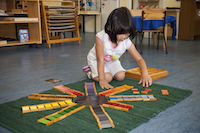 A core learning area in a Montessori Prepared Environment for young children (from birth to 6 years of age). It includes activities that develop and refine the 5 senses--seeing, hearing, touching, tasting, and smelling. The Montessori Materials used in the sensorial area materials were created to help young children in the process of creating and organising their intelligence. Each material isolates a quality found in the world (such as colour, size, shape, etc.) to allow children to focus their attention on this one aspect. | |
Skill outcomesA type of learning outcome specific to a Montessori Professional Learning Series course. It is a specific list of what students should be able to do by the end of the course or module. | ||
Summative assessmentOne of two types of assessments. These are assessment activities designed to formally evaluate student learning. In Montessori Professional Learning Series courses, students enrolled in the Participation Stream are not required to complete the summative assessment activities. Students enrolled in the Certification Stream are required to successfully complete all summative assessment activities to be awarded a Certificate of Attainment. | ||
T |
|---|
The 3-period lessonA 3-step technique used by Montessori Teachers for presenting new information to a child. In the first--the introduction or naming period--the teacher demonstrates what "this is.” (The teacher might say "This is a mountain” while pointing to it on a 3-dimensional map.) In the second--the association or recognition period--the teacher asks the child to "show” what was just identified ("Show me the mountain”). Finally, in the recall period, the teacher asks the child to name the object or area. Moving from new information to passive recall to active identification reinforces the child's learning and demonstrates her mastery. | |
W |
|---|
Work
She observed that young children learn best when given the opportunity to engage in "hands-on” activities of their own choosing, as opposed to following the instructions of an adult. What Montessori preferred to call the "work of childhood”, some educationalists call "play”. What is certain is that children are serious when engaged in the kind of activity that meets developmental needs and, given freedom and time, will choose purposeful activities over frivolous make-believe ones. [fa-link] The Five Characteristics of Play--And of Montessori Work | |

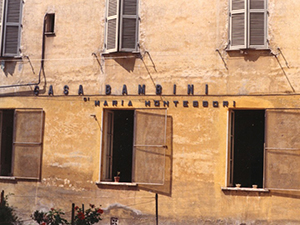
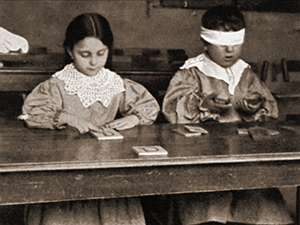
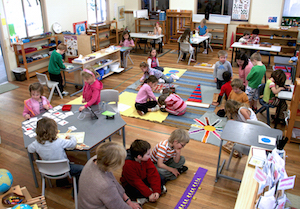
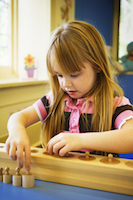
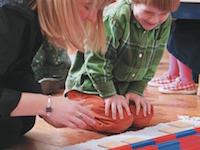 The label used by Montessori for the lead teacher in a Montessori classroom.
The label used by Montessori for the lead teacher in a Montessori classroom. 
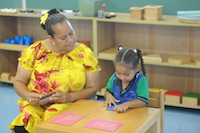 The label used by Montessori for the lead teacher in a Montessori classroom.
The label used by Montessori for the lead teacher in a Montessori classroom. 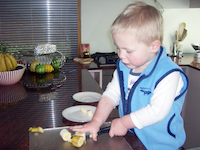 Is a common term, used to describe a state in which an individual does not need to depend on another.
Is a common term, used to describe a state in which an individual does not need to depend on another.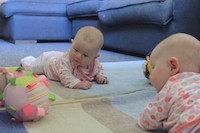 (In Italian: "Nest”). The name often given to a classroom specifically prepared for infants between 2 - 14 months of age.
(In Italian: "Nest”). The name often given to a classroom specifically prepared for infants between 2 - 14 months of age.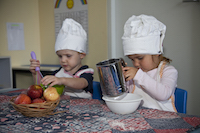 A core learning area in a Montessori
A core learning area in a Montessori 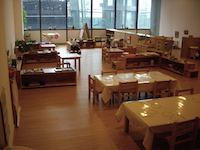 The Montessori classroom is an environment prepared by the adult for children. All aspects of the environment are carefully selected, thoughtfully arranged and sequentially presented to match the developmental needs of the children using the space. Everything is child-sized to encourage children to do things independently.
The Montessori classroom is an environment prepared by the adult for children. All aspects of the environment are carefully selected, thoughtfully arranged and sequentially presented to match the developmental needs of the children using the space. Everything is child-sized to encourage children to do things independently. 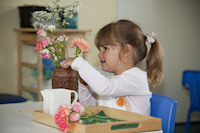 Montessori used this term to describe the purposeful activity of children
Montessori used this term to describe the purposeful activity of children